Fieldwork Support - Recipients of InfoQuest Scholarships
Tracey Thomson, UCR graduate student
2013 recipient of the InfoQuest Scholarship
Swimming reptiles leave tantalizing clues to ecological diversification and aquatic behaviors during the early triassic.
Study focuses on certain types of reptile tracks, called “swim tracks”, from the Lower Triassic Moenkopi Formation of Utah and what they can tell us about paleoenvironments and paleoecology during this time period.
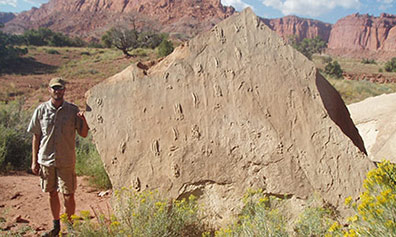
Photo Figure Caption: Tracy Thomson and an excellent example of the reptile swim tracks he is studying from the Lower Triassic Moenkopi Formation in Capitol Reef National Park, Utah.
In the Moenkopi and Red Peak Formations of Arizona, Utah, and Wyoming, skeletal remains of the terrestrial reptiles populating the land following the Permian/Triassic extinction are rare. That doesn’t mean they left no trace of their existence, however. University of California, Riverside graduate student Tracy Thomson, recipient of a 2013 InfoQuest scholarship, is studying the tracks left behind in the sediments as the feet of swimming reptiles scraped the bottom of shallow bodies of water.
The Permian/Triassic mass extinction was the largest in earth history and resulted in the restructuring of the marine and terrestrial realms. The nature of this biotic recovery is critical to our understanding of how ecosystems recover from and are restructured after such events. Recovery in the marine realm is considerably better understood than that in the terrestrial realm largely because of the nature of the fossil record. The Lower Triassic Red Peak and Moenkopi formations are the oldest stratigraphic record of terrestrial rocks from the post-extinction time interval cropping out throughout Wyoming and the Colorado Plateau (UT, NV, AZ, and NM). These units thus form a well-exposed and widespread natural laboratory for investigating the aftermath of this extinction in the terrestrial realm. They also provide the first window in time for studying the Early Triassic radiation of reptiles and their behaviors.
In the Moenkopi Formation very few reptiles, mostly large archosauriforms, are known from actual skeletal remains and no tetrapod remains of any kind have been reported from the Red Peak Formation. However, diverse vertebrate tracks attributed to various types of reptiles are ubiquitous throughout these Lower Triassic deposits indicating that reptiles undoubtedly comprised a diverse and ecologically important part of the fauna at that time. A common and geographically widespread component of these track assemblages are swim tracks produced under subaqueous conditions by buoyant or partially buoyant animals. The purpose of my research is threefold: 1) document and describe these swim tracks with their associated trace fossil and sedimentological contexts; 2) test the hypothesis that these swim tracks were formed by different types of reptiles swimming in shallow water, continental/marine transitional environments (e.g., estuaries, deltas, tidal flats); 3) place these swim tracks and their paleoecological implications into the context of known Triassic reptilian biodiversity.
Due to the paucity of reptile skeletal remains from the Lower Triassic deposits of western North America, reptile tracks (including swim tracks) are invaluable, as well as integral, to our understanding of Early Triassic reptile diversity, evolution, and paleoecology. As evidence of aquatic behavior, swim tracks give unique insights into reptilian behaviors during this time period which cannot be gained by other means. They also provide an opportunity to study the paleoecology of a well-preserved portion of the terrestrial realm during the Early Triassic, the diversity and aquatic behaviors of reptiles at that time, and the degree to which these ecosystems had recovered from the Permian/Triassic mass extinction in North America. Because a similar diversity of reptile tracks, including swim tracks, is known from coeval strata in Europe to which trace fossils from western North America can be compared, behavioral and paleoenvironmental interpretations from this study have implications for understanding the global restructuring of ecosystems after the Permian/Triassic mass extinction.
Allison L. Keller, UCR graduate student
2014 recipient of the InfoQuest Scholarship
2014 Paleontological Society field course on Stratigraphic Paleobiology, south-central Montana.
Through the generosity of the InfoQuest Foundation, I was able to attend a special field course on Stratigraphic Paleobiology sponsored by the Paleontological Society. It was taught in south-central Montana by two of the best in the field, Drs. Steve Holland of the University of Georgia and Mark Patzkowsky of Penn State. With an undergraduate degree in biology and minor in geology I was looking for additional field experience. As my master’s thesis involves data on fossils collected from stratigraphic successions, this course was particularly relevant. With a select group of 11 other graduate students from all over the United States and abroad, two graduate student teaching assistants, and the two faculty and the financial assistance from InfoQuest I had an intense, concentrated and rewarding experience that will serve me well through my master’s degree and onward to a PhD.
Although I admit to being nervous about my field experience in comparison to my fellow students as time went on I found everyone agreeable and great to learn from. In fact, some also came from a biology background. We worked on several different projects in a variety of areas. We had the chance to stay at Indiana’s Judson Mead Field Station based near Cardwell, Montana for a week and a half of this time since many of the locations were around there. Working in small groups or with a partner most of the time, we investigated five main field localities and practiced measuring sections with the Jacob staff and Brunton compass.
THE MISSISSIPPIAN LODGEPOLE FORMATION
In the Mississippian Lodgepole Formation I learned how to distinguish and name different bedsets – defined by lithology, thickness, evenness, continuity, sedimentary structures, Ichnofabric index, grain size and other characteristics. This was a crucial step in determining what facies were present; from deep subtidal, foreshoal, shoal, to peritidal. This is important information for interpreting the environment in which enclosed fossils lived and/or were buried in. Close inspection also allowed us to pinpoint parasequence boundaries to aid in correlation of sections.
This framework also provided structure for faunal counts and Drs. Holland and Patzkowsky spent several days teaching us their methods for collecting and identifying fossils, carefully noting their position in the sequence and characteristics of the rocks they were found in. In the evenings, back at camp, there was still much work to be done identifying fossils and compiling the day’s data.
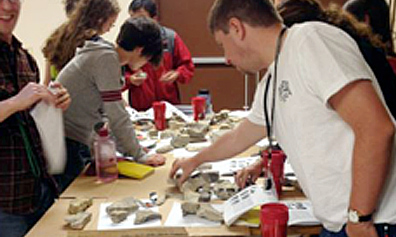
Photo Figure Caption: A group fossil identification workshop back at camp in the evening.
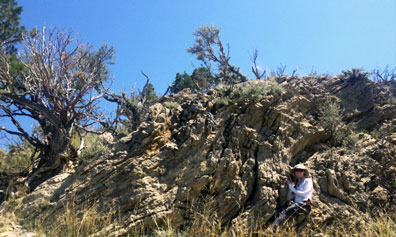
Photo Figure Caption: Me providing a scale for a rare fold of the Lodgepole Formation.
We spent a couple of days at another exposure of the Lodgepole Fm collecting similar data to compare to our first site. We were much quicker this time with all our experience from the first locality. (Future field campers take note—always carry a rain jacket, especially in a place where weather is unpredictable.)
All told we tallied over 3000 faunal specimens in 93 field counts from 5 different depositional environments. Want to know more? By the end of camp, we had already submitted two abstracts on our results to The Geological Society of America for a presentation in the fall at the meetings in Vancouver.
THE CAMBRIAN SOUTH BOULDER RIVER SECTION OF SEPKOSKI
Just outside the Judson Mead Field Station is a hill exposure of the Cambrian age Wolsey Shale, Meagher Limestone, Park Shale, and Pilgrim Limestone. The famous paleontologist Dr. Jack Sepkoski did his dissertation on these rocks. This was another day spent practicing naming bedsets and really getting into the distinctions between them. What I found interesting was that the facies were laterally adjacent at one time, there’s a gradual change to the biofacies going up the Meagher hill but then it is abrupt once going over the hill into the Park Formation. This happens again in the next formation. Mark and Steve informed us that these facies’ abrupt changes correlate to Biomear boundaries. This is where weird extinctions occur possibly due to a stratigraphic artifact. It is curious because it may just be ecological shifts as opposed to turnover, or possibly extinction, or maybe it is both.
CRETACEOUS KOOTENAI FORMATION
Before leaving the field station, we worked in the Cretaceous Kootenai Formation for one of the most memorable and fun group activities, in spite of my sunburn. We split into small groups and each measured and logged a different section along strike. At the end of the day each group placed a line on the large panoramic image Mark and Steve brought to show where they walked up the section. Letters placed along these lines indicated the various facies encountered. Parallel lines to the resistant beds were then made by individual students and an overall image of what beds went all the way through, as opposed to those that thinned out and disappeared between sections, was made clear.
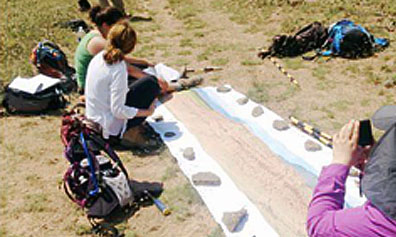
Photo Figure Caption: Work on the kootenai Formation Large Image project.
THE MISSOURI BREAKS and DINOSAUR FOSSILS
Staying for a couple of nights in the very small town of Winifred, MT, we had the opportunity to observe the Missouri Breaks, Judith River – with geologist Dr. Ray Rogers and his paleontologist wife Dr. Kristi Curry-Rogers. Their dig sites offered amazing scenery even though it was a smoky day from a wildland fire in Washington, hundreds of miles to the west. It offered yet another place to practice measuring section and taking faunal logs in groups. What this section offered that the others didn’t was a chance to help Ray and Kristi out by collecting any fossils we found. Ranging from fossil leaves to dinosaur teeth to turtle shells, we sadly couldn’t collect anything for ourselves, but happily could assist them in their permitted search of the area. Although my MS research focuses on marine species in the Late Cretaceous period, it was still very exciting and amazing to get to see dinosaur fossils.
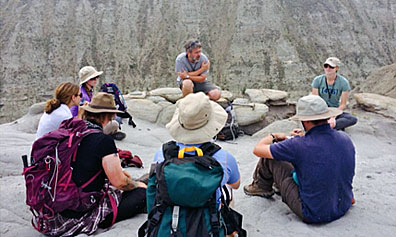
Photo Figure Caption: Group meeting before starting our dinosaur search. Amy Singer photo.
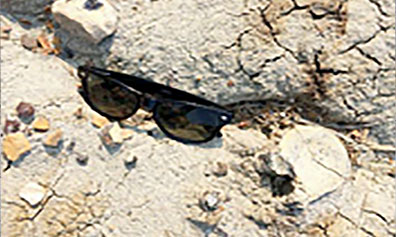
Photo Figure Caption: Success! Dinosaur vertebra in place. Sunglasses for scale. Joyce Yager photo.
THE MUSEUM OF THE ROCKIES and LOTS OF DINOSAURS
For the last group trip we took before flying out of Bozeman, one of the smallest commercial airports I have ever been to, we made our way to the Museum of the Rockies early the next morning. The museum houses one of the largest dinosaur collections! These include those found by dig crews led by paleontologist Jack Horner. This was definitely one of the best ways to end a great geology trip around south-central Montana.
I am very thankful for InfoQuest’s support. I learned a great deal in my time in Montana and I am truly honored to have been selected to go by the Paleontological Society and funded by InfoQuest. This was one of the best field and networking opportunities to be a part of. Although only a short two weeks, the knowledge gained felt equivalent to a quarter’s worth of information and skills and is something that will stick with me for the rest of my life.
© Paleonquest Paleontological Expeditions - 2016 Web Design and Development by Desertmoon Arts.

